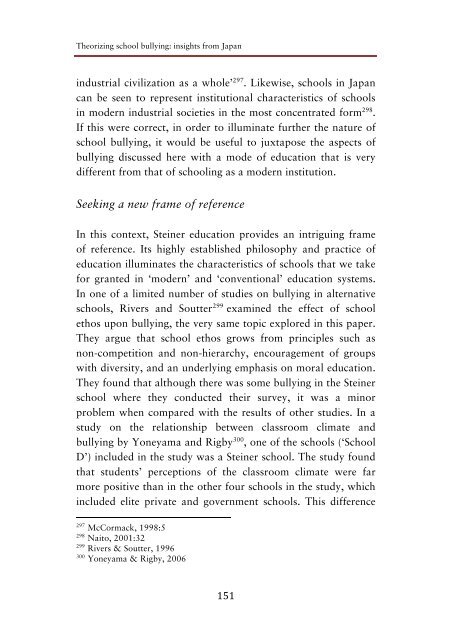You also want an ePaper? Increase the reach of your titles
YUMPU automatically turns print PDFs into web optimized ePapers that Google loves.
Theorizing school bullying: insights from Japan<br />
industrial civilization as a whole’ 297 . Likewise, schools in Japan<br />
can be seen to represent institutional characteristics of schools<br />
in modern industrial societies in the most concentrated form 298 .<br />
If this were correct, in order to illuminate further the nature of<br />
school bullying, it would be useful to juxtapose the aspects of<br />
bullying discussed here with a mode of education that is very<br />
different from that of schooling as a modern institution.<br />
Seeking a new frame of reference<br />
In this context, Steiner education provides an intriguing frame<br />
of reference. Its highly established philosophy and practice of<br />
education illuminates the characteristics of schools that we take<br />
for granted in ‘modern’ and ‘conventional’ education systems.<br />
In one of a limited number of studies on bullying in alternative<br />
schools, Rivers and Soutter 299 examined the effect of school<br />
ethos upon bullying, the very same topic explored in this paper.<br />
They argue that school ethos grows from principles such as<br />
non-competition and non-hierarchy, encouragement of groups<br />
with diversity, and an underlying emphasis on moral education.<br />
They found that although there was some bullying in the Steiner<br />
school where they conducted their survey, it was a minor<br />
problem when compared with the results of other studies. In a<br />
study on the relationship between classroom climate and<br />
bullying by Yoneyama and Rigby 300 , one of the schools (‘School<br />
D’) included in the study was a Steiner school. The study found<br />
that students’ perceptions of the classroom climate were far<br />
more positive than in the other four schools in the study, which<br />
included elite private and government schools. This difference<br />
297<br />
McCormack, 1998:5<br />
298<br />
Naito, 2001:32<br />
299<br />
Rivers & Soutter, 1996<br />
300<br />
Yoneyama & Rigby, 2006 <br />
151


